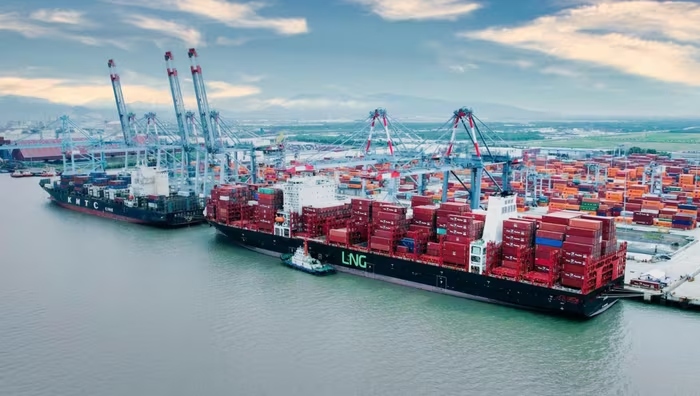Outstanding Advantages After the Merger
At the end of September, the World Bank and S&P Global Market Intelligence released the Container Port Performance Index (CPPI) for the 2020–2024 period. According to the ranking, the Cai Mep port cluster continues to hold firm at the 7th position globally, surpassing major ports such as Singapore, Hong Kong, and Tanjung Pelepas.

The proposed International Maritime Center is located in the Cai Mep - Thi Vai area. Photo: CMIT.
This not only affirms Cai Mep’s position on the global maritime map but also opens up new development potential for Ho Chi Minh City’s port system after the merger.
At a recent meeting, Mr. Pham Quoc Long, Chairman of the Vietnam Ship Agents, Brokers, and Maritime Services Association (Visaba), stated: “This is the right time for Ho Chi Minh City to build an international maritime center located in the Cai Mep - Thi Vai area.”
According to Mr. Long, Ho Chi Minh City after the merger holds outstanding advantages — located near international shipping routes, with naturally deep and stable channels, minimal sedimentation, favorable weather conditions year-round, and a rapidly developing multimodal transportation system including waterways, roads, and aviation.
With a population of about 14 million people, accounting for nearly 10% of the national workforce, the city possesses the necessary infrastructure, economic, financial, and service conditions to form a regional-scale maritime hub.
Mr. Long further noted that global maritime centers usually comprise around 20% port infrastructure, 50% maritime services such as brokerage, ship management, classification, finance, insurance, repair, and shipbuilding, and 30% operational environment, including policies, customs, taxation, and logistics indicators.
The establishment of a Free Trade Zone and bonded logistics area in Ho Chi Minh City will serve as an important driver for developing the international maritime center.
Flexible Multimodal Connectivity
Mr. Le Quang Trung, Deputy General Director of Vietnam Maritime Corporation (VIMC), analyzed that the region currently has several major maritime hubs such as Singapore, Hong Kong, and Shanghai. However, Vietnam still enjoys competitive advantages due to its geographical position, located right on one of the world’s key shipping routes.
In addition, Vietnam has the flexibility to connect via road, rail, air, and waterway, expanding trade networks to neighboring countries.
“While Singapore mainly handles transshipment cargo, Vietnam has a major advantage in export-import goods and the potential to attract foreign investment,” said Mr. Trung, emphasizing that if an international maritime center is established in Ho Chi Minh City, it would not compete but complement other regional hubs, contributing to the growth of the global logistics ecosystem.
According to Mr. Pham Anh Tuan, General Director of Portcoast Consultant Corporation, currently, the Asia–Europe shipping route passing through the Ho Chi Minh City area accounts for more than 40% of the world’s container throughput. Meanwhile, domestic cargo from southern Vietnam makes up over 30% of the total goods through Vietnam’s seaports. Specifically, container cargo in the Ho Chi Minh City – Cai Mep area accounts for about 70% of the nation’s total container volume.
In terms of infrastructure, Cai Mep Port is capable of accommodating vessels over 232,000 DWT, and its logistics system and post-port infrastructure are being heavily invested in, aiming toward multimodal transportation.
Many logistics centers and support service zones have also been planned, creating significant growth potential for Vietnam’s maritime and logistics industries in the coming period.
Need for Open Policies and Synchronized Infrastructure
According to the Detailed Master Plan for port groups, terminals, berths, mooring buoys, and water zones for the 2021–2030 period with a vision to 2050 approved by the Prime Minister, Ho Chi Minh City’s seaport system after the merger currently includes 80 ports with 188 berths.
Among them, the Cai Mep - Thi Vai area has 24 ports and 45 berths, with channel depths averaging from 14 to 16.8 meters, capable of handling large vessels.
Despite these advantages, experts believe several “bottlenecks” must be removed if Ho Chi Minh City is to realize its goal of developing an International Maritime Center.
One of the urgent requirements is to establish open and transparent mechanisms and policies, especially in customs and port operations, to facilitate the growth of international transshipment cargo.
At the same time, it is necessary to improve transportation connectivity, develop logistics centers and inland ports, and encourage businesses to invest in green shipping, digitalization, and automation services.
Mr. Pham Anh Tuan emphasized that international maritime centers are always associated with financial hubs and free trade zones. Therefore, Ho Chi Minh City needs breakthrough policies to create an integrated maritime-financial ecosystem that connects maritime finance, insurance, and international enterprises.
The early implementation of automated customs declaration systems will help shorten clearance times and reduce administrative procedures, thereby enhancing the competitiveness of Vietnam’s seaports. It is also crucial to build a unified data ecosystem for the port network, allowing seamless information sharing between authorities, shipping lines, and cargo owners.
According to Mr. Pham Quoc Long, adjusting container handling service prices is an important solution to generate reinvestment capital for port infrastructure and technology.
Currently, container handling fees at Vietnam’s deep-water ports are only about half of those in the region. Specifically, at Cai Mep, the average rates are 57 USD per 20-foot container and 85 USD per 40-foot container — equivalent to only 51–53% of Singapore’s rates and 43–44% of Hong Kong’s (China).
The Vietnam Maritime and Inland Waterways Administration said it is developing a plan to adjust deep-water port handling fees to be submitted to the Ministry of Construction.
In addition, the agency is implementing multiple synchronized solutions to address challenges and promote the development of maritime and inland waterway activities in line with national master planning, optimizing the efficiency of Vietnam’s seaport system.